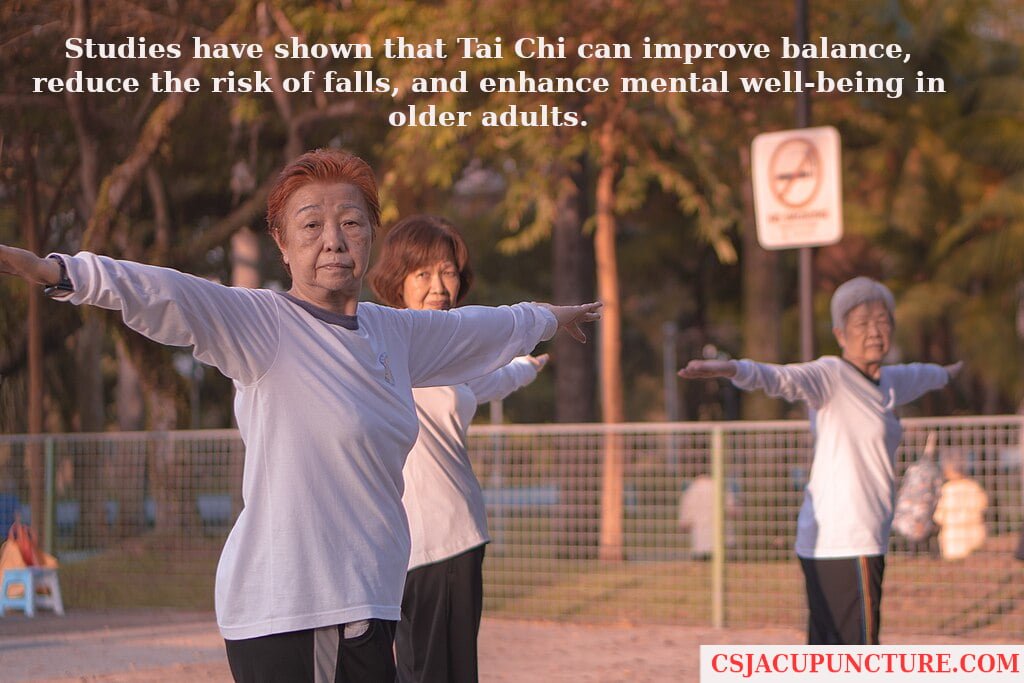This post may contain affiliate links and ads in which we may earn a small percentage of purchases.
Photo credit: scott1346 wikicommons
Table of Contents
As an acupuncturist with extensive clinical experience and over 15 years of practicing Tai Chi, I want to discuss an important topic to all people especially our geriatric community (Geriatric: relating to old people, especially with regard to their healthcare, oxford), which is Tai Chi for seniors. Many people believe Tai Chi is beneficial for “old people” simply because it involves slow movements, but there’s much more to it.
Jump-start your metabolism with the 21-Day Smoothie Diet! Replace meals with delicious, nutrient-packed smoothies that help burn fat, boost energy, and keep you feeling full. Start your transformation today →
Tai Chi improves balance, promotes mental relaxation and clarity, and enhances circulation. Tai Chi has multidimensional effects, including physical, psychological and quality of life benefits for a wide range of conditions.1 However, it’s often relegated to an older demographic, which means younger people miss out on its benefits, too. However, that is a discussion for a different time. Here, I want to focus on why Tai Chi is particularly safe and effective for older individuals.

Ready to uncover who your true soulmate is? Discover the face, energy, and connection meant for you with a personalized Soulmate Reading. Reveal your soulmate today →
The Safety of Tai Chi For Seniors
Slow Movements
The slow, deliberate movements of Tai Chi are gentle on the joints and muscles, reducing the risk of injury. This makes it an ideal exercise for seniors who may have mobility issues or chronic pain.
Improved Balance
Tai Chi helps improve balance by focusing on postural alignment and controlled movements. Both feet are placed evenly on the ground, which builds sensory and neuromotor pathways, enhancing overall balance.
Mental and Physical Benefits
Tai Chi is not just about physical exercise; it’s also about mental well-being. The practice encourages mental relaxation and clarity, which can reduce stress and anxiety.
Research and Evidence
Studies have shown that Tai Chi can improve balance, reduce the risk of falls, and enhance mental well-being in older adults. The combination of slow movements, focused breathing, and mental relaxation makes it a comprehensive exercise. Tai Chi appears most promising for improving hypertension, preventing falls among community-dwelling older adults, and enhancing cognitive performance in older adults.2
Other conditions include osteoarthritis, Parkinson disease, chronic obstructive pulmonary disease (COPD).3

Tai Chi and Medical Conditions
Tai Chi is excellent for individuals with various medical conditions because it’s a non-competitive, self-improvement exercise. It provides natural biofeedback, helping individuals understand how their bodies move and improve their awareness and coordination.
Clinically significant benefits were most consistently reported with Tai Chi practice for conditions including Parkinson’s disease, falls risk, knee osteoarthritis, low back pain, cerebrovascular, and cardiovascular diseases including hypertension4.
Stroke Recovery
I’ve worked with stroke recovery patients who have seen significant improvements in their range of motion and balance through tailored Tai Chi programs.
High Blood Pressure
Patients with high blood pressure benefit from the gentle, consistent movement and the stress-reducing aspects of Tai Chi, which can improve overall cardiovascular health. A systematic review of 18 RCTs showing significant improvements in blood pressure metrics.5
More quality studies are needed, but this is very promising for patients as a potential therapy to learn.
General Wellness
Even patients who are well and want to improve their overall health can benefit from Tai Chi. It enhances flexibility, strength, and coordination.
Incorporating Tai Chi into Your Routine
Frequency
For optimal benefits, practicing Tai Chi two to three times a week with an instructor is ideal. For those familiar with the practice, daily sessions can provide even greater benefits.
Complementary Exercises
While Tai Chi offers a well-rounded workout, incorporating some upper body weight training can enhance overall strength. Tai Chi builds the foundation and strength needed to perform other activities and exercises that you enjoy.
Practical Benefits
Improved Range of Motion
I’ve seen patients improve their range of motion significantly. For instance, a patient who could barely lift their knee was able to lift it close to 90 degrees after consistent weekly Tai Chi practice.
Gait Improvement
Many patients experience immediate improvement in their gait after just one session. While progress can fluctuate, the overall trend is towards better balance and mobility.
The Holistic Approach
Tai Chi works on multiple levels: it improves muscle and tendon strength, enhances circulation, and even addresses the fascia. The practice encourages a holistic improvement in physical and mental health.
Breathing and Cardiovascular Health
Tai Chi incorporates deep, focused breathing, which enhances cardiovascular health and supports overall well-being.
Sensory and Neuromotor Benefits
The slow movements help build sensory awareness and neuromotor coordination, crucial for maintaining balance and preventing falls.
Recommendations For Tai Chi Practice
Start Slow
Begin with a qualified instructor to learn the basics and ensure proper form. Once comfortable, you can practice on your own or join group sessions.
Consult Your Healthcare Provider
Before starting any new exercise regimen, consult with your healthcare provider to ensure it’s safe for you, especially if you have existing health conditions.
Consistency is Key
Aim for regular practice—at least once a week, but ideally more often. Consistent practice will yield the best results in terms of both physical and mental health benefits.
Tai Chi is a safe and effective exercise for seniors, offering numerous benefits such as improved balance, mental clarity, and overall physical health. While it won’t solve all health problems, it makes them more manageable and enhances overall quality of life. By incorporating Tai Chi into your routine, you can enjoy a holistic approach to health and well-being.
- Yang, GY., Hunter, J., Bu, FL. et al. Determining the safety and effectiveness of Tai Chi: a critical overview of 210 systematic reviews of controlled clinical trials. Syst Rev 11, 260 (2022). https://doi.org/10.1186/s13643-022-02100-5. Retrieved June 13th, 2024 from https://systematicreviewsjournal.biomedcentral.com/articles/10.1186/s13643-022-02100-5 ↩︎
- Solloway, M.R., Taylor, S.L., Shekelle, P.G. et al. An evidence map of the effect of Tai Chi on health outcomes. Syst Rev 5, 126 (2016). https://doi.org/10.1186/s13643-016-0300-y. Retrieved June 13th, 2024 from https://systematicreviewsjournal.biomedcentral.com/articles/10.1186/s13643-016-0300-y ↩︎
- Huston P, McFarlane B. Health benefits of tai chi: What is the evidence? Can Fam Physician. 2016 Nov;62(11):881-890. PMID: 28661865; PMCID: PMC9844554. Retrieved June 113, 2024 from https://www.ncbi.nlm.nih.gov/pmc/articles/PMC9844554/ ↩︎
- Yang, GY., Hunter, J., Bu, FL. et al. Determining the safety and effectiveness of Tai Chi: a critical overview of 210 systematic reviews of controlled clinical trials. Syst Rev 11, 260 (2022). https://doi.org/10.1186/s13643-022-02100-5. Retrieved June 13th, 2024 from https://systematicreviewsjournal.biomedcentral.com/articles/10.1186/s13643-022-02100-5 ↩︎
- Solloway, M.R., Taylor, S.L., Shekelle, P.G. et al. An evidence map of the effect of Tai Chi on health outcomes. Syst Rev 5, 126 (2016). https://doi.org/10.1186/s13643-016-0300-y. Retrieved June 13th, 2024 from https://systematicreviewsjournal.biomedcentral.com/articles/10.1186/s13643-016-0300-y ↩︎
Unlock the Power of Your Mind
Discover The Brain Song — a sound-based system that helps boost focus, balance emotions, and recharge your energy naturally.
Medical Disclaimer: This article is for informational and educational purposes only and is not a substitute for professional medical advice, diagnosis, or treatment. Always consult a qualified healthcare provider with any questions about a medical condition or treatment.





